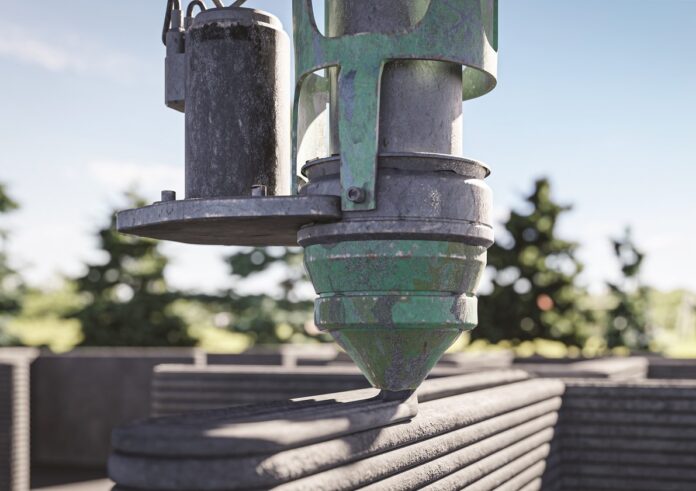Brine valorization is being researched as a potential waste product from desalination that can be used as a concrete accelerator for the 3D printing of concrete. Noura Chehab, Mohammed Alsindi, Nikolay Voutchkov, Hussain Bukannan, and Fatima Bukhari describe the process and its benefits.
NEOM is a new region being built from the ground up in the north-west of Saudi Arabia – driving solutions to the world’s most pressing issues. One of NEOM’s primary goals is to develop and implement at-scale solutions for water scarcity and pollution, minimising water costs and eradicating waste. ENOWA, the water and energy company of NEOM, is leading this charge, and has brought together world-leading experts within the energy and water sectors to advance infrastructure development, investment, and testing of groundbreaking technology.
ENOWA Water is designing infrastructure that uses the most forward thinking technologies, working in collaboration with leading international organisations. This water infrastructure is being built using renewable energy technology and circular economy principles, where seawater desalination will be integrated with brine processing and 100% wastewater recycling and recovery of resources will achieve zero-liquid discharge (ZLD), with no environmental runoff, by 2030.
Centre of excellence
The recently created ENOWA Water Innovation Center (WIC) focuses on the development of applied research projects that support ENOWA’s strategic plans and objectives. Focused on developing solutions that reduce waste, recover resources, and foster environmental and fiscal sustainability, WIC develops and manages new ideas and technologies as a centre of excellence in desalination, smart water technology, seawater mining and advanced wastewater treatment. Core to ENOWA’s strategy is the implementation of circular economic models where by-products, such as brine from desalination, are revalued as resources.
Brine reuse
Brine generated from desalination plants and industrial production processes contains high salt content. Its discharge into aquatic or terrestrial habitats can have negative environmental impacts on these habitats. One of the WIC projects proposes reusing brine as a concrete accelerator to be used in the production of 3D-printable concrete.
Accelerating admixtures are added to concrete to increase the rate of stiffening, setting or hardening, with concrete containing an accelerator setting faster than the equivalent plain concrete. The reduction in setting time is typically one to two hours depending on the type of accelerator, dose and temperature. Typical chemicals used for acceleration are calcium nitrate, calcium nitrite, calcium formate, and aluminium compounds.
ENOWA’s innovative approach applies brine as a concrete accelerator, mixed with water to create a printing system involving two pumpable composites: one with Portland cement, using low concentration brine, and the other using concentrated brine. The concentrated brine is a mix of two streams (as presented in Figure 1). The resulting product has a compressive strength suitable for use as a construction material for structures and art applications. This technology is currently undergoing validation, with testing ongoing to establish the optimum mix ahead of rollout to industrial scale.
The process
Synthetic brine was prepared based on the mass balance calculations from brine streams provided by the NEOM brine processing plant. This was established to dispose of brine generated as a by-product of desalination sustainably and to optimise the opportunity to develop a revenue stream by harvesting minerals and metals that are found in the brine. These brine streams were selected for their compositions which were deemed most suitable for 3D printed concrete (3DPC). Synthetic concentrated brine (Streams 2+3) was used as a concrete accelerator and synthetic low concentration brine (Stream 1) was applied as mixing water for the concrete. Different concentrations of brine were prepared, with the major limiting factor being the saturation point of the salt used. The different concentrations were achieved by modifying the salt content in each of the prepared brines. Stream 1 brine was also tested at different concentrations, with the change in concentration being achieved through dilutions with tap water.
Transformative technology
3D printable concrete using brine offers a novel solution for brine valorization and has the potential to revolutionise the desalination and construction industries. In addition, this novel application can reduce the use of cement, reduce waste, lower CO2 emissions, and promote sustainability.
Using desalination brine to produce a concrete accelerator will enable ENOWA to lead the regional concrete accelerator market, which, according to IndustryArc’s 2021 Market Report, is forecast to reach $1.5 bn globally by 2026, supported by rapid urbanisation and construction. Financial assessment of the brine-based concrete accelerator indicates that it can be produced at a 10-40% lower cost than conventional accelerators, making it a fiscally viable and environmentally responsible alternative.
The authors: Dr Noura Chehab is head of R&D and innovation at ENOWA, Mohammed Alsindi is senior project engineer at ENOWA, Nikolay Voutchkov is executive director of the ENOWA Water Innovation Center, Hussain Bukannan is process engineer at ENOWA, and Fatima Bukhari is project specialist at NEOM.








